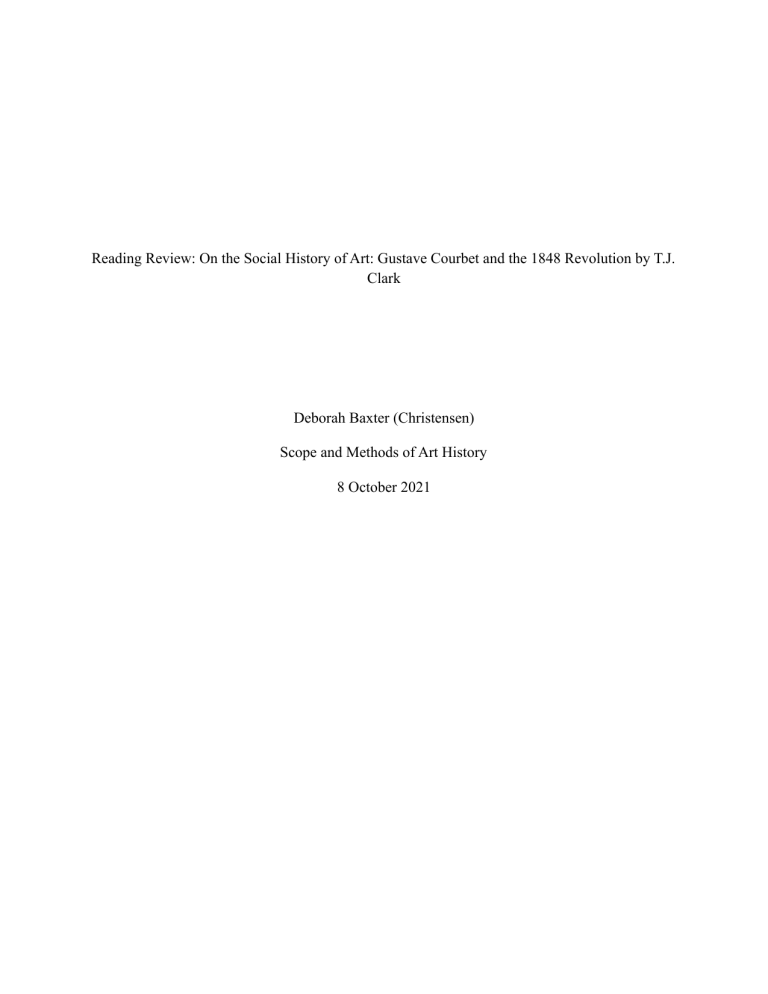Reading Review On the Social History of Art Gustave Courbet and the 1848 Revolution by T
advertisement

Reading Review: On the Social History of Art: Gustave Courbet and the 1848 Revolution by T.J. Clark Deborah Baxter (Christensen) Scope and Methods of Art History 8 October 2021 1 In the first chapter of T. J. Clark’s 1973 book, Image of the People: Gustave Courbet and the 1848 revolution, “On the Social History of Art,” Clark attempts to generalize the procedures he will employ and his reasoning for them in his highly specific study of three years of the French realist’s life and work. It is a difficult framework to summarize due to its insistence on specificity. His central argument refutes Hegelian and Formalist attempts to explain the larger patterns, changes, and styles of art history because they were too general and created a constructed ideology of specific artworks’ and artists’ place in history. The connoisseurs, with their emphasis on individual genius, did not properly account for the individual artist’s point of view, not just “influenced” by a “background” history, but as an active entity with individual political, social, and class motivations. Clark also rejects the tendency of iconologists to rely on intuitive analogies, preferring iconological interpretation that is specific and overt, he says, “flirting with hidden analogies is worse than working openly with inelegant ones.”1 The solution to these problems and the goal of Clark’s social art history is to study an extremely limited period of an individual artist’s work in order to gain a comprehensive and concrete understanding of all the interconnections between the artist’s specific, political point of view, and his friends, artistic traditions and ideologies, historical situation, conception of his public, relationship with critics, etc. His five concerns of socialist art history deal with how the artist and the work relate to 1) classicism vs. realism, 2) Individualism, 3) Sanctification or subversion of the bourgeoisie, which relates to whether the artist himself identifies as bourgeois or an outcast 4) How the art deals with popular imagery and its ties to class politics, and 5) the withering away of art, relating to technology and social utility. I agree with the depth of research necessary to gain a complete picture of how an artwork is situated historically and strongly agree with the notion that not all individual artists from the 1 Clark, “On the Social History of Art,” 11 2 same period were influenced by their social circumstances in the same ways or held the same beliefs. Overall, I am fascinated by his choice of topic, and am personally more interested in art with a clear political perspective and purpose, than art for art’s sake, sensationalism, or literary/historical subjects. I want to read the rest of the book and learn more about how Courbet’s work changed the world. However, I also see two weaknesses in Clark’s approach. First, while Clark does acknowledge the political bias in his reasoning for studying only three years of Courbet’s work, the method cannot be applied universally where historical information at the level of specificity he requires no longer exists. Second, its specific focus abandons the hermeneutic problem. His explanation of changes in art across time prioritizes a biased political ideology that does not necessarily apply, for example, to societies without a bourgeoisie class. In fact, the self-limited evidence he uses really only proves his thesis about three years in France. My personal frustration with the dense, highly philosophical, often self-contradictory/self-attenuating style of the framework laid out in the first chapter would hopefully ease once he got into the meat of the matter in the rest of the book. Clark begins and ends the chapter with enigmatic quotes by Baudelaire and Mondrian prophesying an end to art. Hatt and Klonk elaborate that Clark was “Marxist enough to believe that no art can bring about the only social change that really matters: a revolution in the ownership of the means of production.”2 Another socialist art historian, Patricia Leighten, contradicts this idea by pointing out Picasso’s political activism, and the impact of his anti-war works. Leighten’s perspective here seems far less caught up in a constructed socialist “ideology,” to me. I side with Clark, however, where Leighten diverges from his methodology and only 2 Hatt, “Marxism and the Social History of Art,” 137 3 focuses on, “what the artist has intentionally conveyed.”3 Clark’s insistence on seeking out the blindspots, engaging with what may have prevented certain representations, and noting the artist’s prejudices would produce a far more holistic, socially situated analysis, though the task of supporting an argument of what is not in the artwork is daunting, if not impossible. 3 Hatt, 138 4 Bibliography Clark, T. J. “On the Social History of Art.” Essay. In Image of the People: Gustave Courbet and the 1848 Revolution, 9–20. Princeton, New Jersey: Princeton University Press, 1973. Hatt, Michael, and Charlotte Klonk. “Marxism and the Social History of Art.” Essay. In Art History: A Critical Introduction to Its Methods, 120–40. Manchester, MI: Manchester University Press, 2006.


